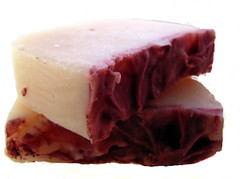There are a number of ways soap is created by hand...here are a rundown of the most popular techniques:
Cold Process
Al's Fruit Stand by Metropolis
Cold Process is the method that is most popular by seasoned soapers. It involves using lye and a combination of oils and fats to create the process of Saponification, or turning the oils into soap! The fresh soap must cure for a period of 4-6 weeks before being used safely. This method allows for a number of artistic designs and can be vegan or use tallow and/or lard.
Hot Process
Tangerine Pomegranate Soap by Soapy Blessings
Hot Process is the oldest method of soap, dating back to the middle ages! It involves using lye and a combination of oils and fats, but unlike Cold Process it involves using heat to speed up saponification, usually resulting in ready-to-use soap! It has a different texture than Cold Process because the soap solidifies so quickly that it usually has to be "glopped" into the molds. This method is a little less giving than cold process, but some have been able to create beautiful artisan soaps using Hot Process.
Melt and Pour
Floating Dots Soap by Soapy Love
Melt and Pour is created by melting down a soap-like base, adding colorants and additives, then pouring into molds. The soap is usually ready to use as soon as it cools. Melt and Pour is usually how a lot of artisans get into soap-making because it's very easy to use. It is great for starters but there are some really advanced techniques that lend to some highly advanced artistic soaps.
Whipped Soap
Lemon Sugar Creme Soap by Cozy Moments
Whipped soap, like melt and pour, comes from a base and involves adding coloring and fragrance then glopping into containers. Whipped soap is pretty fun and there are some great layering techniques that can be used.
Liquid Soap
Spring Blossom Liquid Soap by Vibrant Naturals
Handmade Liquid Soap can be created either from a base like Melt and Pour, or from a process similar to Cold Process soaps involving oils and a form of lye called Potassium Hydroxide. Since it's liquid it has little give for artistic variations, but it can be colored and fragranced.
Types of soap
Tuesday, June 23, 2009 Posted by meg at 6:56 PM | Labels: cold process, hot process, liquid, melt and pour, soap, whippedA Soapie is a special contributor to the blog who sends us fantastic stories/interviews/pics/whatever!
Here's what we're looking for on the blog:
Soap Shops - Got a review of a little soap boutique in your area? Send us pics and some info!
Interviews - Know of a soaper who makes fantastic art soaps? Send us pics and an interview!
Projects/Techniques - Got a great tutorial for a bath/beauty project or want to update us on the newest soaping technique? Send us the info with some pics!
We'll of course be happy to give you credit and link to your super-fantastic website or blog.
Send all submissions to soapsessed@gmail.com
An obsession with all of the bath and beauty products out there, we will catalogue and display the amazing work soap artisans are doing out there (and maybe show some soapwrecks? One can only hope!).


